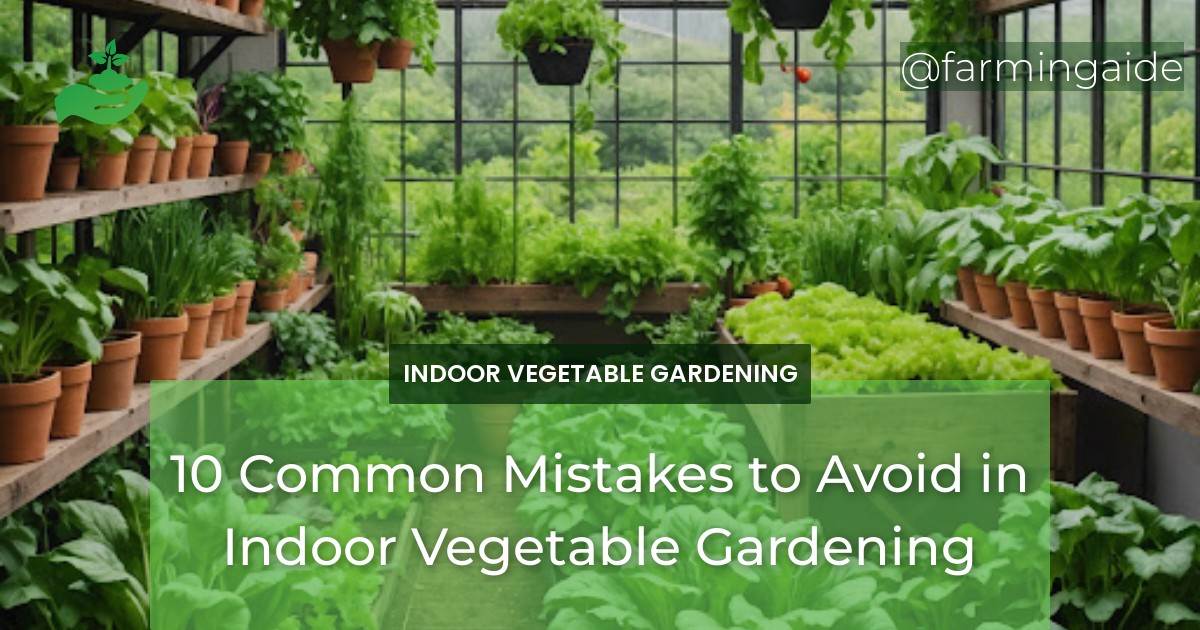Are you tired of struggling with indoor vegetable gardening? Do you find yourself making the same mistakes over and over again? You’re not alone! Many gardeners face common challenges that can be easily avoided with a little knowledge and planning. In this article, we’ll explore the 10 most common mistakes to avoid in indoor vegetable gardening, so you can finally enjoy a bountiful harvest from the comfort of your own home.
Key Takeaways
- Choosing the wrong plants for indoor gardening can lead to failure.
- Inadequate lighting can hinder plant growth and development.
- Overwatering or underwatering can be detrimental to plant health.
- Poor soil quality can negatively impact plant growth and productivity.
- A lack of essential nutrients can limit plant growth and development.
Introduction to Indoor Vegetable Gardening
Indoor vegetable gardening is a great way to grow your own food, even with limited space. With a little creativity and planning, you can create a thriving indoor garden that provides fresh produce all year round. However, many gardeners face common challenges that can be easily avoided with a little knowledge and planning.
In this article, we’ll explore the 10 most common mistakes to avoid in indoor vegetable gardening, so you can finally achieve success and enjoy a bountiful harvest from the comfort of your own home.
Benefits of Indoor Vegetable Gardening
Indoor vegetable gardening offers many benefits, including:
- Fresh produce all year round
- Control over growing conditions
- Pest and disease management
- Increased food security
- Year-round harvesting
Common Challenges in Indoor Gardening
Indoor gardening can be challenging, especially for beginners. Some common challenges include:
- Limited space and light
- Soil quality and nutrient management
- Pest and disease management
- Temperature and humidity control
- Lack of experience and knowledge
Mistake 1: Choosing the Wrong Plants
Choosing the wrong plants for indoor gardening can lead to failure. Not all plants are suitable for indoor gardening, and some may require specific conditions that are difficult to replicate indoors.
To avoid this mistake, it’s essential to choose plants that are specifically bred for indoor gardening or have low light requirements.
ALSO READ
Best Plants for Indoor Gardening
Some of the best plants for indoor gardening include:
- Leafy greens (lettuce, kale, spinach)
- Herbs (basil, cilantro, parsley)
- Microgreens (radish, arugula, pea shoots)
- Vegetables (cherry tomatoes, cucumbers, carrots)
Factors to Consider When Choosing Plants
When choosing plants for indoor gardening, consider the following factors:
- Light requirements
- Soil and nutrient requirements
- Temperature and humidity tolerance
- Space and growth habits
Mistake 2: Inadequate Lighting
Inadequate lighting can hinder plant growth and development. Most plants require a certain amount of light to undergo photosynthesis and grow.
To avoid this mistake, it’s essential to provide adequate lighting for your plants.
ALSO READ
Importance of Light for Indoor Plants
Light is essential for plant growth and development. It provides energy for photosynthesis, which is necessary for plant growth and development.
Types of Lighting Solutions
There are several types of lighting solutions available for indoor gardening, including:
- Natural light
- Fluorescent lighting
- LED lighting
- HPS (high-pressure sodium) lighting
Mistake 3: Overwatering or Underwatering
Overwatering or underwatering can be detrimental to plant health. Overwatering can lead to root rot and other problems, while underwatering can cause plants to become stressed and weakened.
To avoid this mistake, it’s essential to monitor soil moisture and adjust watering schedules accordingly.
Signs of Overwatering and Underwatering
Some common signs of overwatering and underwatering include:
- Yellowing or droopy leaves
- Waterlogged soil
- Wilted or soft stems
- Slow growth or stunted plants
Optimal Watering Techniques
Optimal watering techniques include:
- Monitoring soil moisture
- Watering in the morning
- Avoiding overwatering
- Using a well-draining potting mix
Conclusion: Mastering Indoor Vegetable Gardening
In conclusion, indoor vegetable gardening can be a rewarding and productive hobby, but it requires attention to detail and a willingness to learn. By avoiding the 10 most common mistakes, you can ensure a successful harvest and enjoy fresh produce all year round.
Recap of Common Mistakes
In this article, we’ve explored the 10 most common mistakes to avoid in indoor vegetable gardening, including:
- Choosing the wrong plants
- Inadequate lighting
- Overwatering or underwatering
- Poor soil quality
- Lack of essential nutrients
- Inappropriate temperature and humidity
- Ignoring pest and disease management
- Incorrect pruning techniques
- Overcrowding plants
- Lack of patience and consistency
Encouragement for Continuous Learning
Indoor vegetable gardening is a continuous learning process. Be open to new ideas and techniques, and don’t be afraid to experiment and try new things. With practice and patience, you’ll be enjoying a bountiful harvest in no time!


